Слайд 3Concepts of Initial Assessment
Rapid Primary Survey
Resuscitation
Detailed Secondary Survey
Re-evaluation
Initiate Definitive Care

Слайд 4Concepts of Initial Assessment
Triage
Sorting of Patients According to
ABCs and Available Resources

Слайд 5Concepts of Initial Assessment
Primary Survey
Adult / Pediatric priorities – Same
A - Airway with

C-Spine Control
B - Breathing
C - Circulation With Hemorrhage Control
D - Disability: Neurologic Status
E - Exposure / Environment
Слайд 6Concepts of Initial Assessment
Primary Survey
Establish Airway
Caution
Cervical Spine Injury

Слайд 11Venturi Mask
FiO2 from 0.24 to 0.40

Слайд 12The Patient Condition
Conscious
Partially/ fully unconscious
A. Spontaneous respiration
1. Occluded/ obstructed
2. Inadequate
B.

Apneic
Слайд 13Signs and Symptoms of Airway Obstruction
Noisy breathing
Effort of breathing: tracheal tugging, intercostal
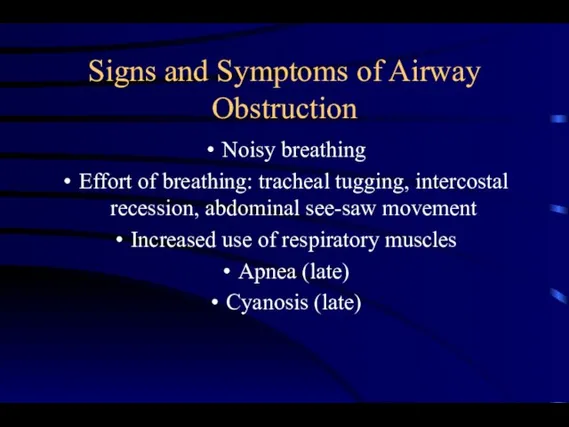
recession, abdominal see-saw movement
Increased use of respiratory muscles
Apnea (late)
Cyanosis (late)
Слайд 14Basic Management of Airway Obstruction
Chin lift and head tilt.
Jaw thrust.
Both maneuvers.
Oro/nasopharingeral airways.
Heimlich
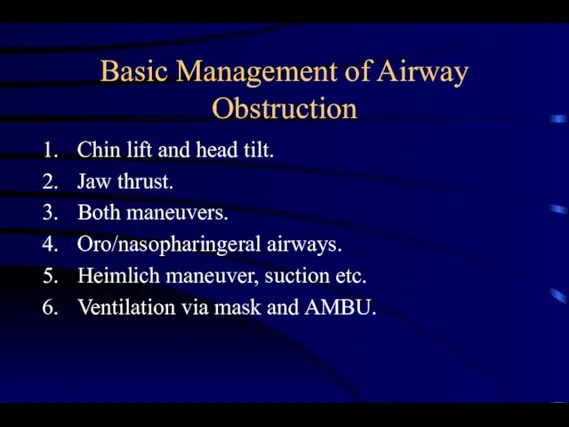
maneuver, suction etc.
Ventilation via mask and AMBU.
Слайд 18Modes of ventilation
Mouth-to-mouse/ mouth-to-nose
Mouth-to-mask
Bag-valve device
Transtracheal jet-ventilation
Automatic transport ventilators
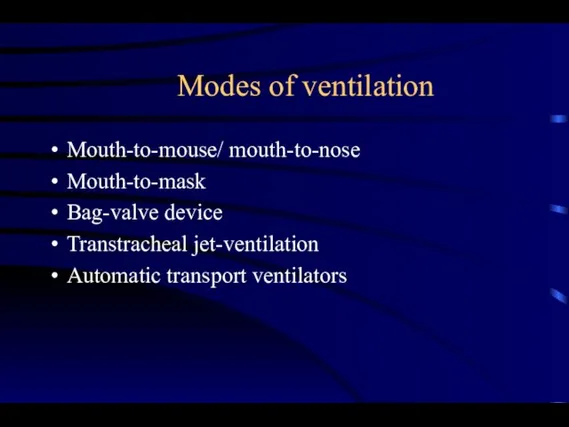
Слайд 19Indications for securing an airway with an Endotracheal tube
Apnea
Obstruction of upper airway
Protection
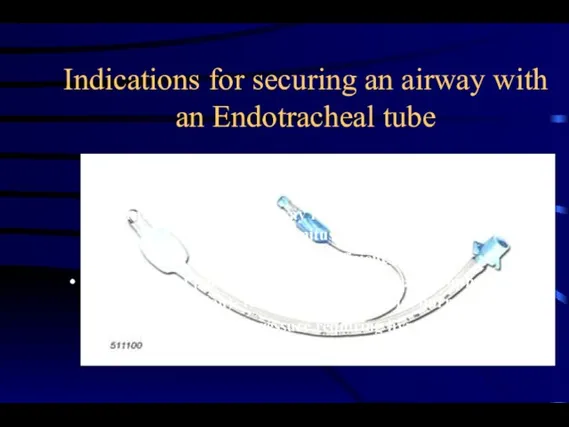
of lower airway from soiling with blood or vomitus
Respiratory insufficiency
Impending of potential compromise of airway (prophylactic intubation)- for example, after facial burns
Raised intracranial pressure requiring hyperventilation
Слайд 21The technique for rapid- sequence intubation is as follows:
1. Preoxygenate the patient
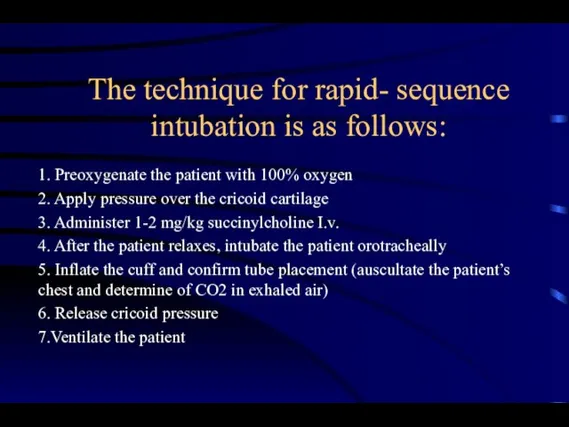
with 100% oxygen
2. Apply pressure over the cricoid cartilage
3. Administer 1-2 mg/kg succinylcholine I.v.
4. After the patient relaxes, intubate the patient orotracheally
5. Inflate the cuff and confirm tube placement (auscultate the patient’s chest and determine of CO2 in exhaled air)
6. Release cricoid pressure
7.Ventilate the patient
Слайд 23“Sniffing Position”
Remember about C-spine protection!!!
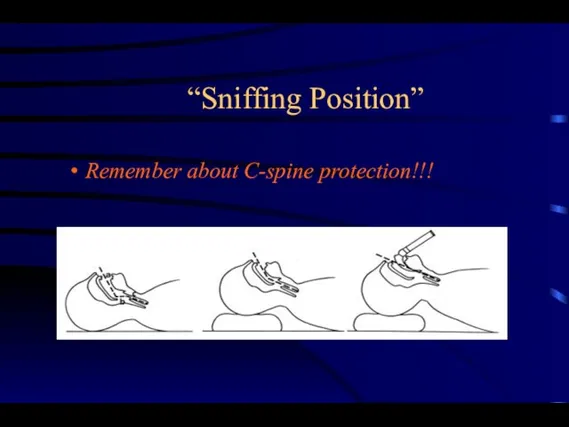
Слайд 29Alternatives to Endotracheal Intubation
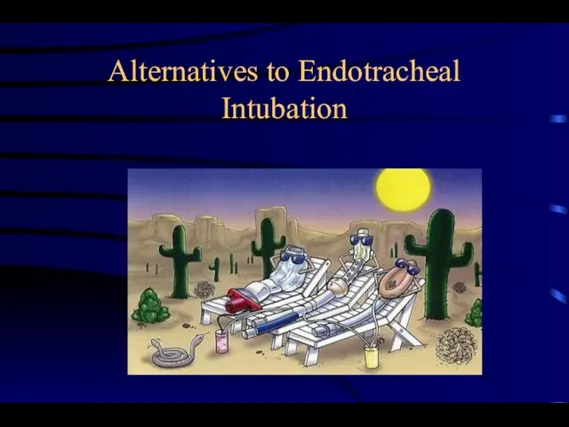
Слайд 30Alternatives to Endotracheal Intubation
Oropharyngeal airway
Nasopharyngeal airway
Laryngeal mask airway
Esophageal-tracheal Combitube®
Crycothyrotomy
Tracheostomy
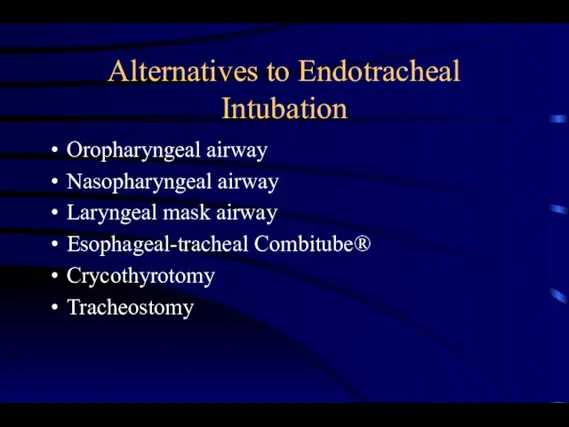
Слайд 38Concepts of Initial Assessment
Primary Survey
Assume C-Spine Injury !!
Multi System Trauma
Altered Level of
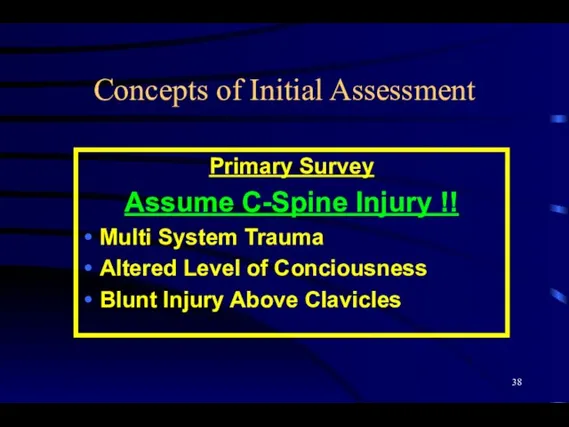
Conciousness
Blunt Injury Above Clavicles
Слайд 39Concepts of Initial Assessment
Primary Survey
Circulation
Assess Blood Volume Loss and Cardiac Output
Level of
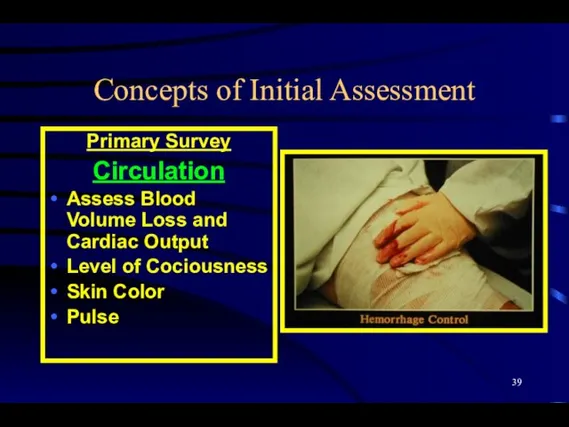
Cociousness
Skin Color
Pulse
Слайд 40Concepts of Initial Assessment
Primary Survey
Disability:
Neurological Evaluation
Level of Conciousness
A - Alert
V – Response
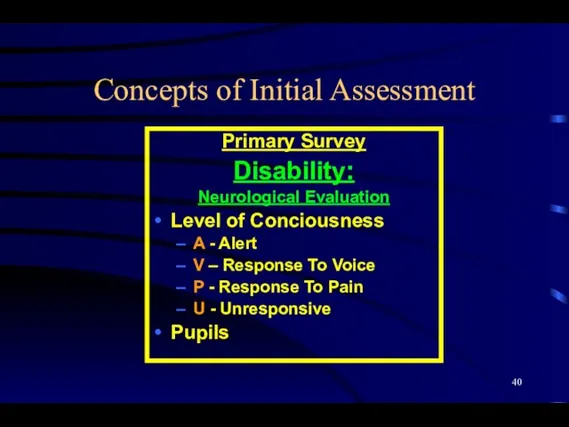
To Voice
P - Response To Pain
U - Unresponsive
Pupils
Слайд 41Concepts of Initial Assessment
Primary Survey
Exposure / Environment
Undress Pt Completely
Protect from Hypothermia
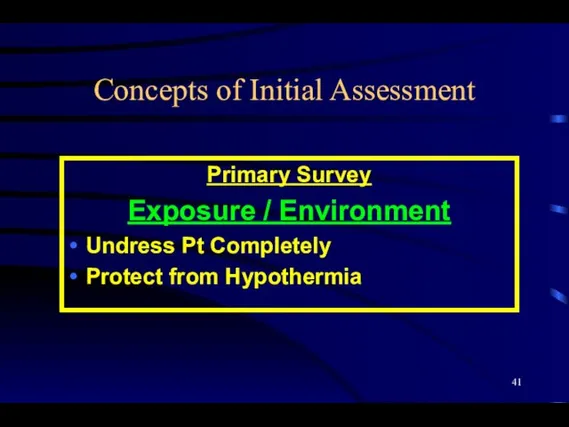
Слайд 42Concepts of Initial Assessment
Resuscitation
Protect / Secure Airway
Ventilate / Oxygenate
Fluid Therapy – New
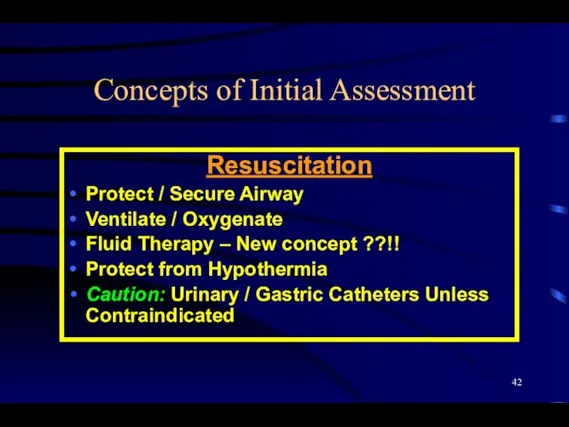
concept ??!!
Protect from Hypothermia
Caution: Urinary / Gastric Catheters Unless Contraindicated
Слайд 43Concepts of Initial Assessment
Protect from Hypothermia
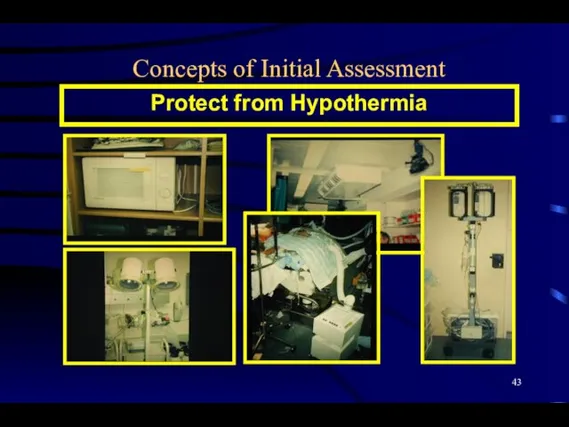
Слайд 44Initial Assessment
Catheter Contraindications
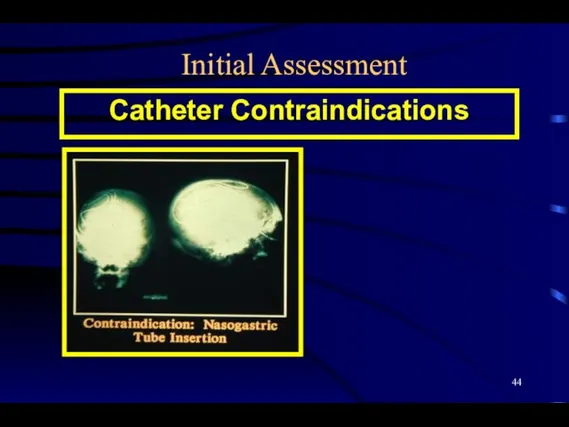
Слайд 45Initial Assessment
Monitor
Vital Signs
Urinary Output
ABGs
ECG, Temp, Pulse Oximetry
Ent\d Tidal CO2
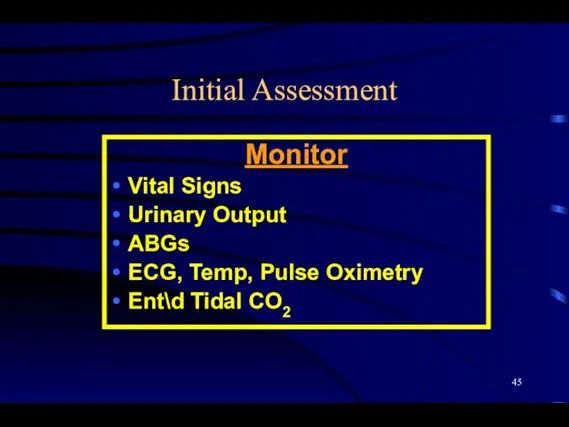
Слайд 46Initial Assessment
Resuscitation
Manage Life-Threatening Injuries In Sequence and as Identified
Consider Need For
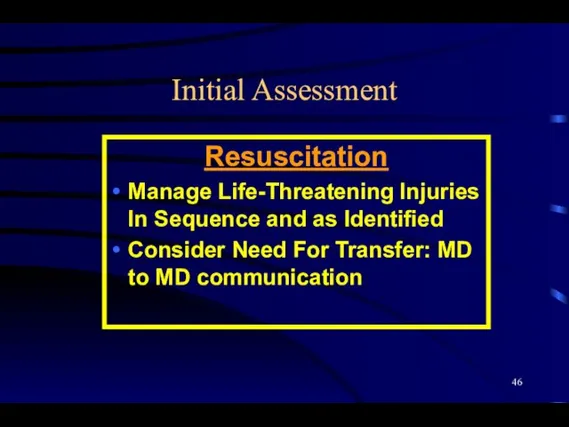
Transfer: MD to MD communication
Слайд 47Initial Assessment
Before 2ry Survey
Complete 1ry Survey
Initiate Resuscitation
Reassess ABGs
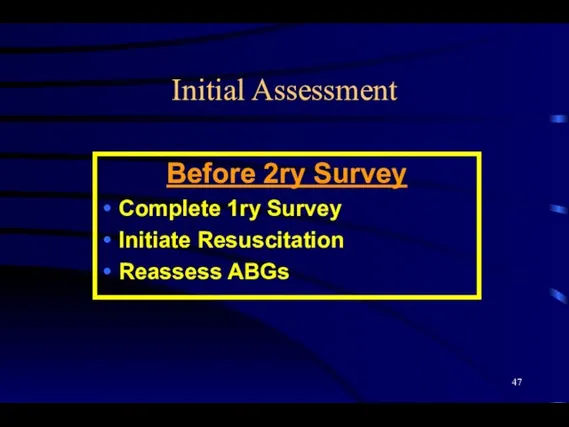
Слайд 48Initial Assessment
Secondary Survey
Head-To-Toe Evaluation
Complete Neurologic Evaluation
X-Rays
Special Procedures (Angio, MRI)
“Tubes & Fingers in
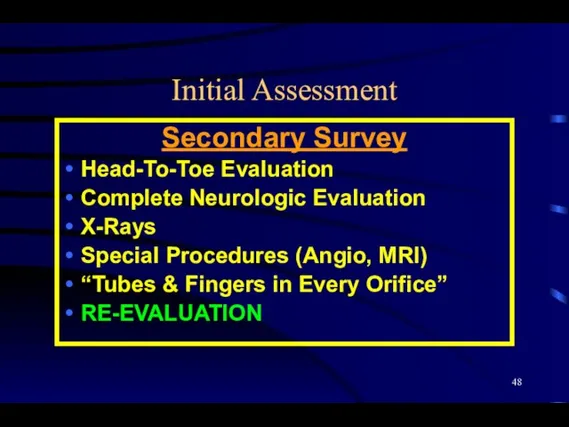
Every Orifice”
RE-EVALUATION
Слайд 49Initial Assessment
“TRAUMA X-Rays”
?
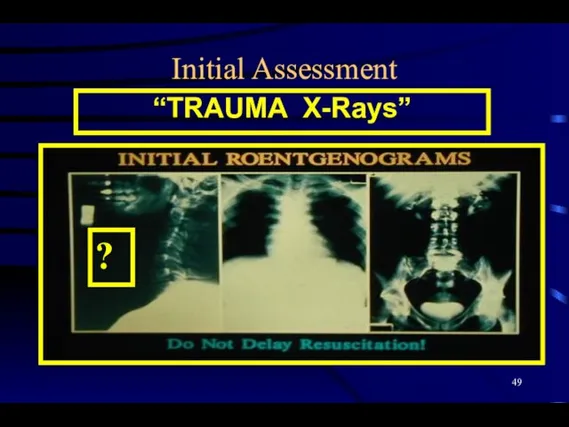
Слайд 50INITIAL ASSESSMENT of THE TRAUMA PATIENT
Initial Assessment
Mobile X-Ray
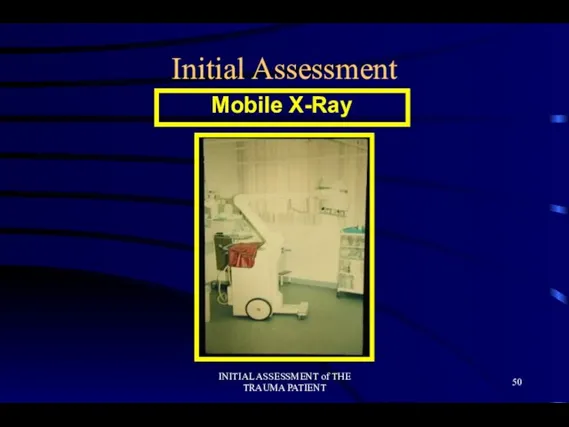
Слайд 51INITIAL ASSESSMENT of THE TRAUMA PATIENT
Initial Assessment
A,B,C,D,E and U(ultra sound)
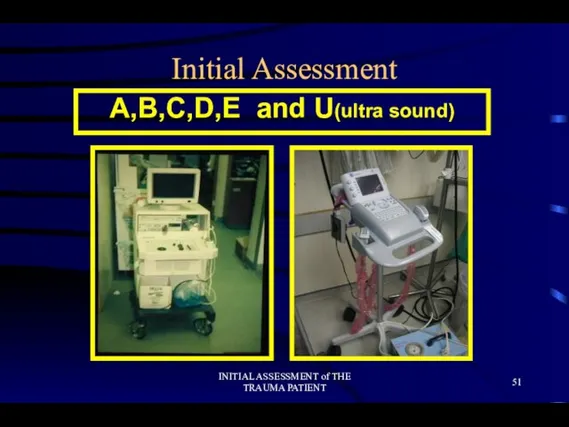
Слайд 52INITIAL ASSESSMENT of THE TRAUMA PATIENT
Initial Assessment
Secondary Survey
Mechanism Of Injury: BLUNT
Direction of
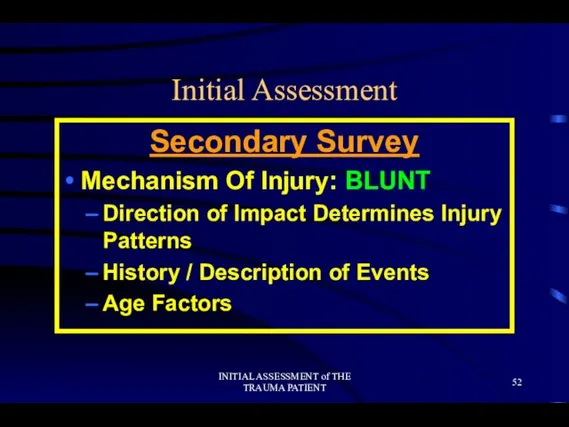
Impact Determines Injury Patterns
History / Description of Events
Age Factors
Слайд 53INITIAL ASSESSMENT of THE TRAUMA PATIENT
Initial Assessment
Secondary Survey
Mechanism Of Injury: Penetrating
Anatomic Factors
Energy
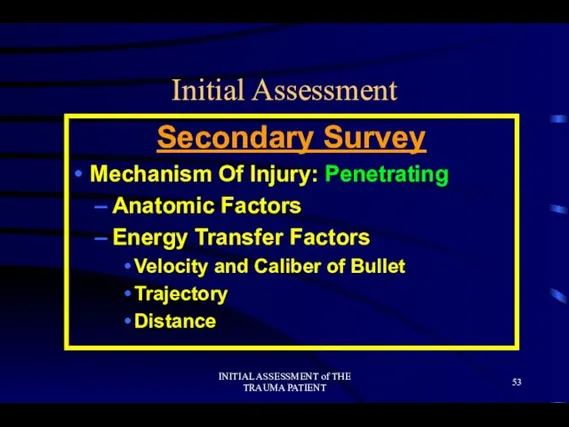
Transfer Factors
Velocity and Caliber of Bullet
Trajectory
Distance
Слайд 54INITIAL ASSESSMENT of THE TRAUMA PATIENT
Initial Assessment
Spine X-Ray Issues
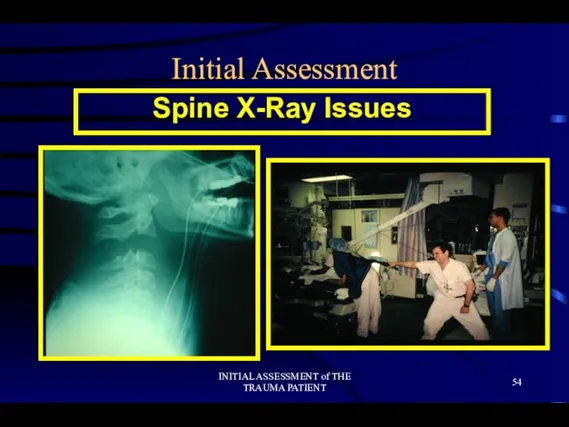
Слайд 55INITIAL ASSESSMENT of THE TRAUMA PATIENT
Initial Assessment
Secondary Survey
Musculoskeletal
Extremities/Pelvis:
Contusions, Deformity, Pain, Crepitation, Abnormal
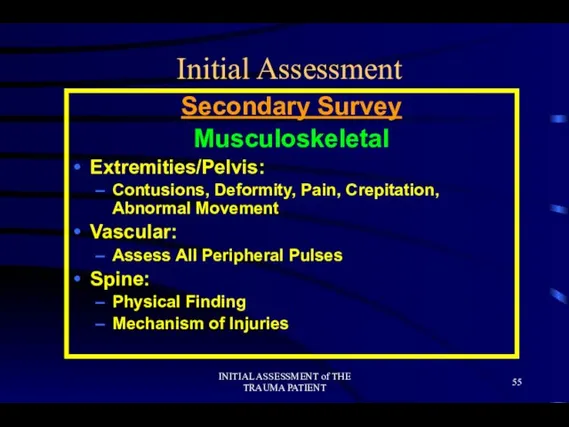
Movement
Vascular:
Assess All Peripheral Pulses
Spine:
Physical Finding
Mechanism of Injuries
Слайд 56INITIAL ASSESSMENT of THE TRAUMA PATIENT
Initial Assessment
Secondary Survey
Neurologic
Determine GCS Score
Re-Evaluate Pupils
Sensory /
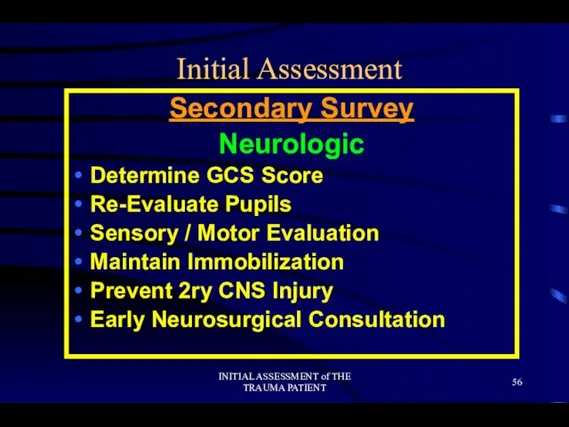
Motor Evaluation
Maintain Immobilization
Prevent 2ry CNS Injury
Early Neurosurgical Consultation
Слайд 57INITIAL ASSESSMENT of THE TRAUMA PATIENT
Initial Assessment
Re-Evaluation
New Findings / Deterioration / Improvement
High
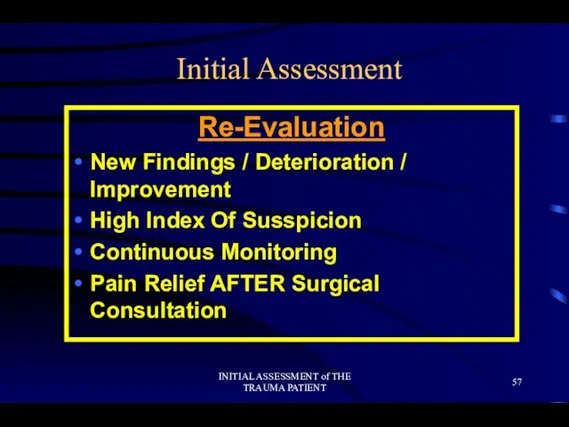
Index Of Susspicion
Continuous Monitoring
Pain Relief AFTER Surgical Consultation
Слайд 58INITIAL ASSESSMENT of THE TRAUMA PATIENT
Initial Assessment
Definitive Care
Trauma Center Vs
Closest
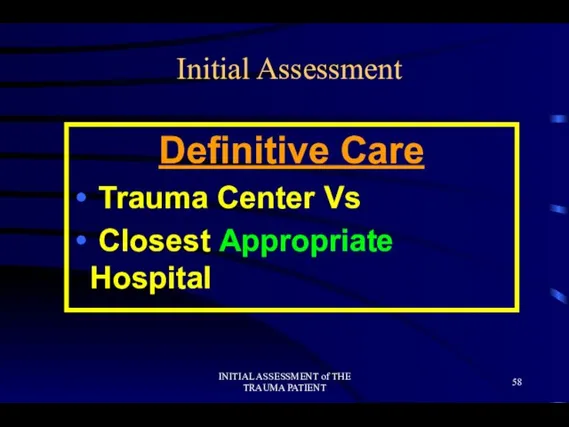
Appropriate Hospital
Слайд 59INITIAL ASSESSMENT of THE TRAUMA PATIENT
Initial Assessment
The Aftermath
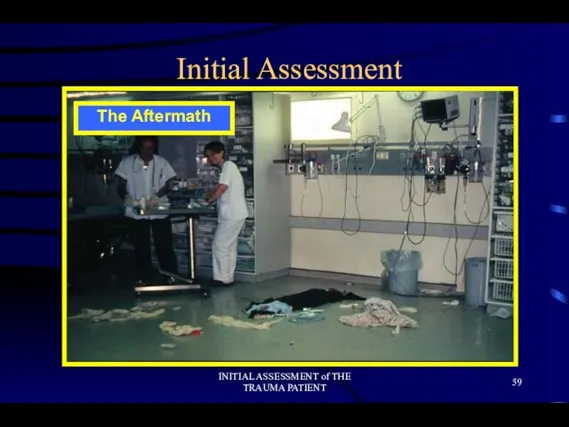













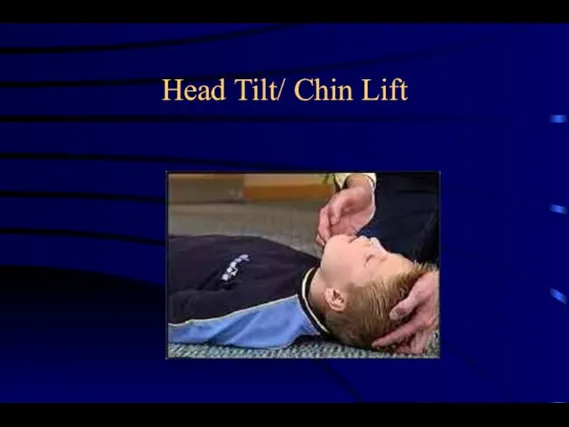
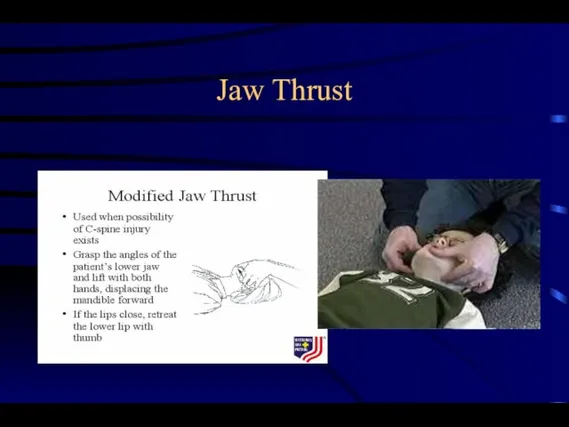
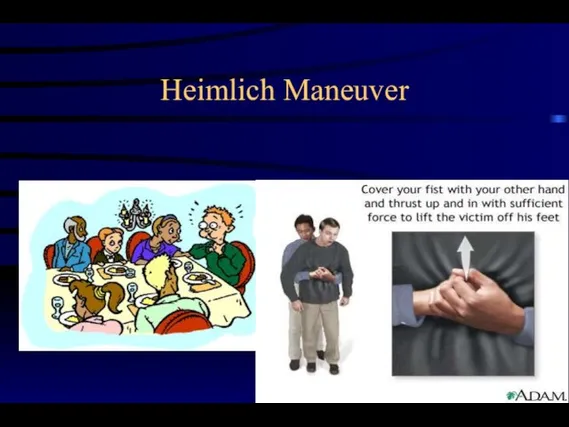


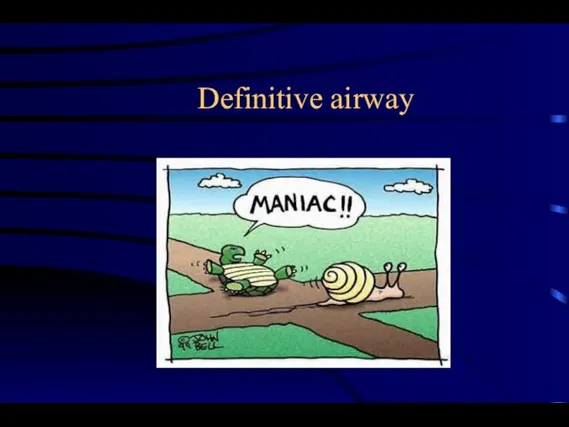

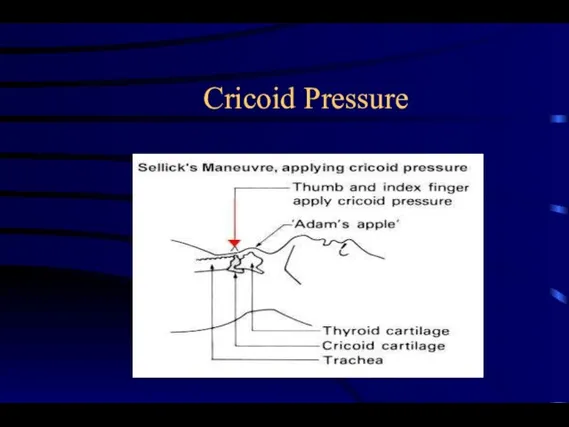

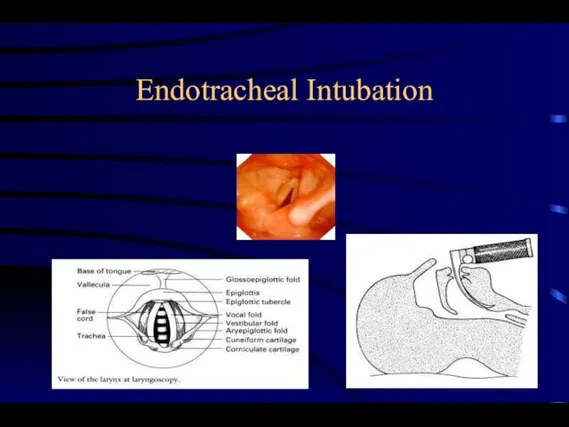
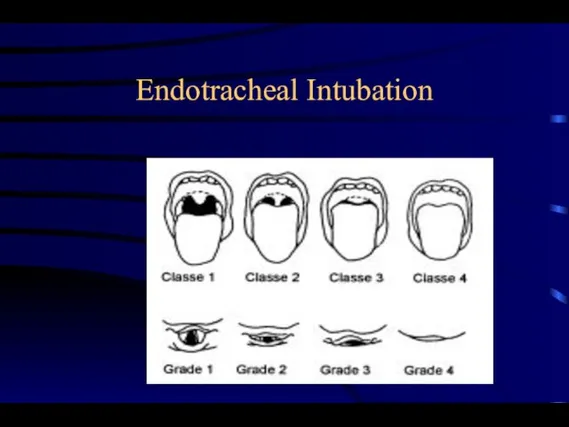
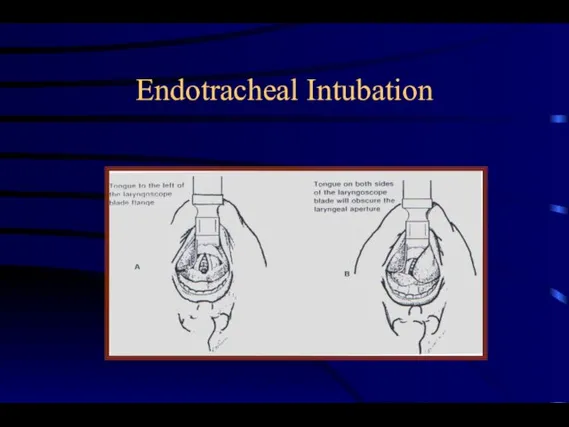
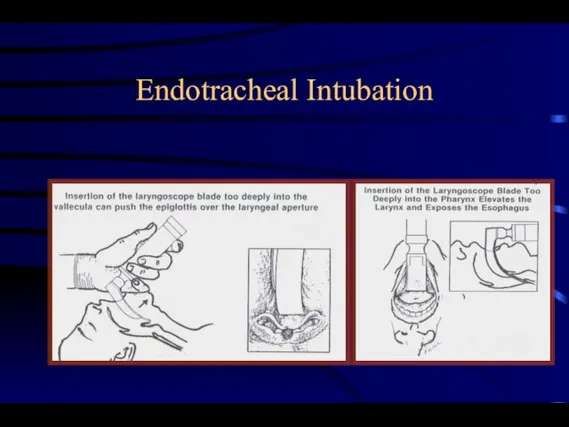
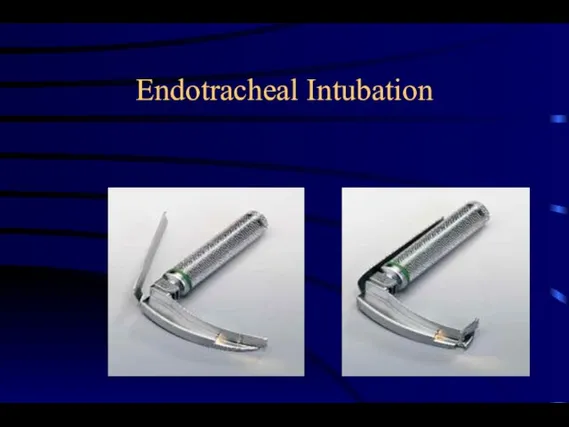


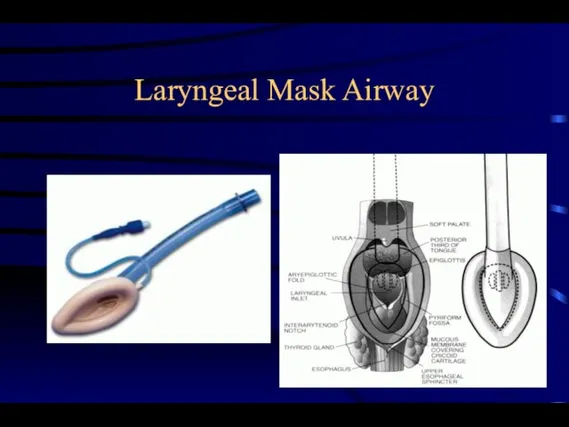
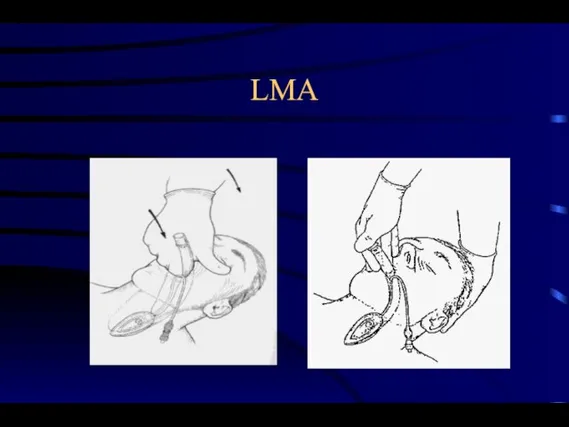
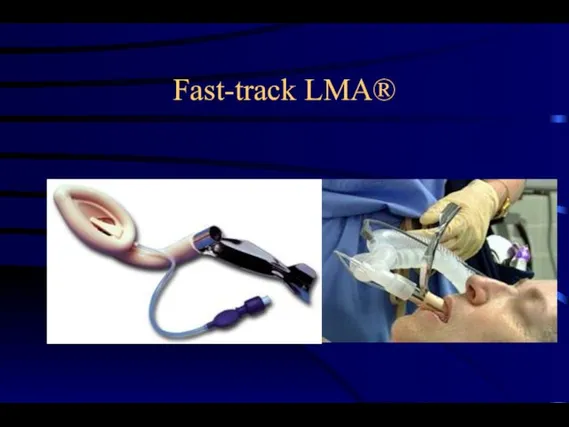
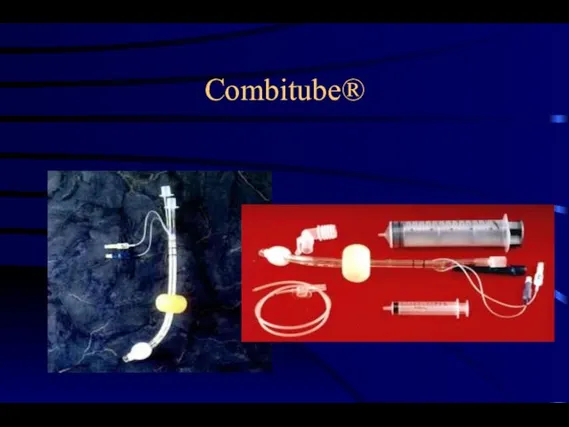
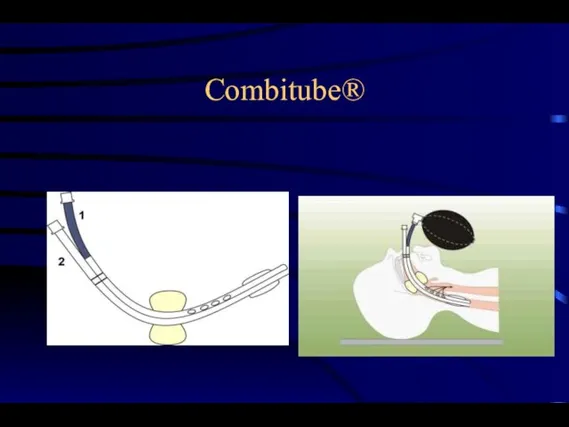
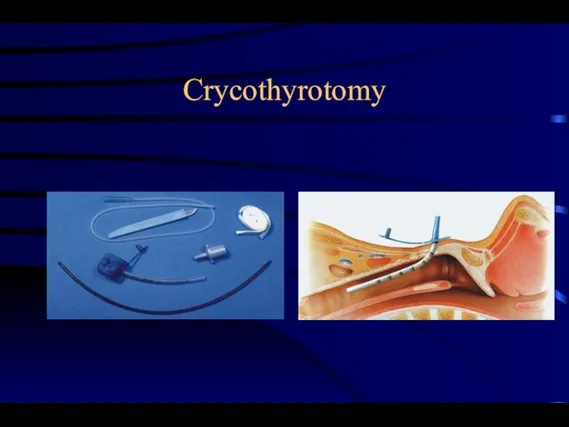
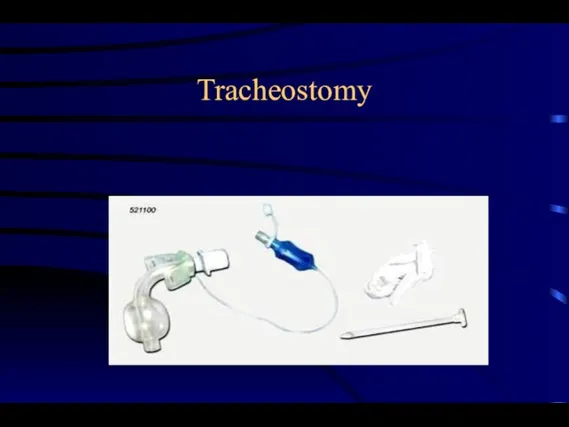






















 Реконструкция ВЛ-0,4кВ КТП-3901
Реконструкция ВЛ-0,4кВ КТП-3901 Ритм. Геометрическая композиция
Ритм. Геометрическая композиция Najväčší dodávatelia cloudových služieb
Najväčší dodávatelia cloudových služieb Виртуализация и автоматизация тестирования мобильных приложений
Виртуализация и автоматизация тестирования мобильных приложений Интеллектуальная игра по станциям Гражданин
Интеллектуальная игра по станциям Гражданин Презентация агентстваОпыт работы на рынке Украины
Презентация агентстваОпыт работы на рынке Украины Washington D.C.
Washington D.C. W w w. a l a d d i n. r uw w w. a l a d d i n – r d. r u Современные подходы к защите персональных данных в медицинских организациях Сабанов А.Г., ЗАО.
W w w. a l a d d i n. r uw w w. a l a d d i n – r d. r u Современные подходы к защите персональных данных в медицинских организациях Сабанов А.Г., ЗАО. Презентация на тему Правописание сочетаний чк, чн (2 класс)
Презентация на тему Правописание сочетаний чк, чн (2 класс) Учет доходов работников организации и их налогообложение
Учет доходов работников организации и их налогообложение Tree frog
Tree frog Российские железные дороги. Аналитическое исследование. Анализ действующего прейскуранта №10-01 на перевозки грузов
Российские железные дороги. Аналитическое исследование. Анализ действующего прейскуранта №10-01 на перевозки грузов Обобщение знаний об арифметической и геометрической прогрессии
Обобщение знаний об арифметической и геометрической прогрессии О себе
О себе Учение о клетке
Учение о клетке Николай Алексеевич НекрасовЛюбовная лирика и ее значение в жизни поэта
Николай Алексеевич НекрасовЛюбовная лирика и ее значение в жизни поэта Роль и значения материала в конструкции
Роль и значения материала в конструкции Кодирование информации (10 класс)
Кодирование информации (10 класс) 1С: КПП. Водители
1С: КПП. Водители Теория противостояния морских и континентальных сил
Теория противостояния морских и континентальных сил Мелашич Оксана Викторовна
Мелашич Оксана Викторовна Рынок социологических и маркетинговых исследований Астраханской области: некоторые результаты инициативного исследования
Рынок социологических и маркетинговых исследований Астраханской области: некоторые результаты инициативного исследования Природные зоны России. Тундра (4 класс)
Природные зоны России. Тундра (4 класс) Институт языка и литературы УдГУ. Кафедра романской филологии, второго иностранного языка и лингводидактики
Институт языка и литературы УдГУ. Кафедра романской филологии, второго иностранного языка и лингводидактики Инклюзивное образование: толерантность, доступность, качество
Инклюзивное образование: толерантность, доступность, качество Проект
Проект Системный подход к использованию современных педагогических технологий на уроках истории и обществознания
Системный подход к использованию современных педагогических технологий на уроках истории и обществознания Тема Родины и Дома в творчестве Марины Цветаевой Выполнила: Горбунова Анастасия Сергеевна, 10 «В»класс, МОУ лицея 57 Руководитель: Ру
Тема Родины и Дома в творчестве Марины Цветаевой Выполнила: Горбунова Анастасия Сергеевна, 10 «В»класс, МОУ лицея 57 Руководитель: Ру